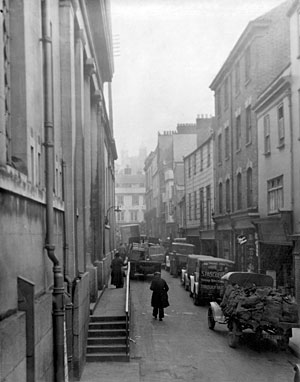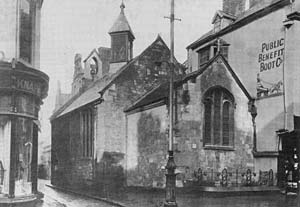
Goldsmith Street
Page updated 14 September 2008
 Linking the High Street to Paul Street, until the
Guildhall Shopping Centre was constructed, this street contained the
goldsmiths of Exeter. It was first named in the 13th century. From the
19th century, the rear façade of Higher Market ran down part of
Goldsmith Street. There is some evidence to suggest that before this
date, it may have been known as Corn Street.
Linking the High Street to Paul Street, until the
Guildhall Shopping Centre was constructed, this street contained the
goldsmiths of Exeter. It was first named in the 13th century. From the
19th century, the rear façade of Higher Market ran down part of
Goldsmith Street. There is some evidence to suggest that before this
date, it may have been known as Corn Street.
Goldsmith Street in the heart of the city, was very close to the Back Grate of the Guildhall, where the lead lined water cistern was housed. Fed from Golsworthy's water engine, the water, although not pure, did not suffer with contamination from the cholera bacteria. As a consequence, only two died from Goldsmith Street in the 1832 outbreak.
Allhallows Church was situated on the right hand side of the entrance to the street from the High Street. By the 19th-Century the position of the church was proving to be a problem for access to Goldsmith Street. A memorial was read, in 1871, to the Streets Committee requesting that the church be removed. No further action was taken at the time, but in 1874, the Committee recommended that a notice be put up requesting that carts and waggons going to the Higher Market should enter the street via Waterbeer Street, and leave by Paul Street. The next year the Surveyor reported that the street had been repaved, while the Council continued to negotiate with the owners of property in the street, with a view to purchase for street widening. They decided to obtain a compulsory purchase order for the properties in 1878, and also considered Goldsmith Street for the proposed, new post-office; neither happened.
For the next twenty-years, the Streets Committee returned several times to the problem of widening Goldsmith Street, but Allhallows Church prevented the work being done, until 1906, when Allhallows Church was finally demolished. Furnishing from the church was transferred to St Pancras, including a Jacobean pulpit and some tablet memorials that are dedicated to victims of smallpox. The Council paid £8 5s for the burials in the church to be moved to Higher Cemetery in April 1906. The remains included those of Stephen Vilvaine died 1556, Simon Gandy, died 1678, Thomas Bampfylde died 1656, and Peter Vilvaine, died 1602 the father of Dr Vilvaine who founded a 'common brewhouse', that eventually became the City Brewery. The site is now occupied by H Samuels.
There was one victim from the 1887 Theatre Royal fire who lived in Goldsmith Street - William James Tucker, an apprentice tailor, attended the theatre with a friend who managed to escape.
There are still two jewellers in the street, one at each end. The map shows Goldsmith Street in 1905.The modern Goldsmith Street is rather shorter than the old street, running from the High Street to Waterbeer Street.
There is a second Goldsmith Street in Heavitree, a continuation of Ladysmith Road.
 Goldsmith
Street circa 1930. Courtesy of the City Parks
Department
Goldsmith
Street circa 1930. Courtesy of the City Parks
Department
 Allhallows Church Goldsmith Street was situated where H Samuels now trade.
Allhallows Church Goldsmith Street was situated where H Samuels now trade.
│ Top of Page │